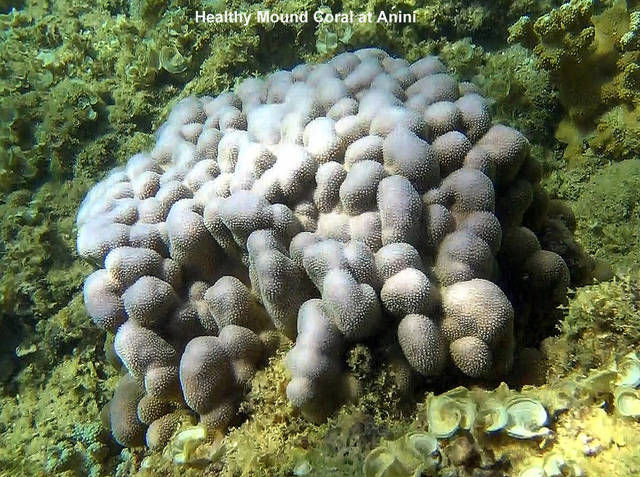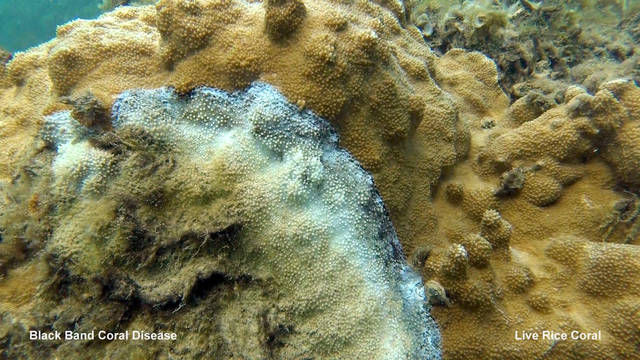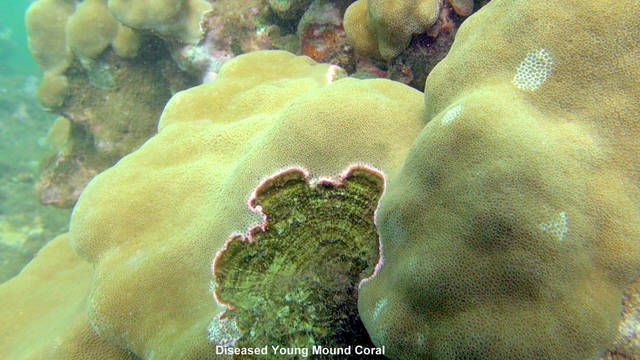HANALEI — Black band disease is once again spreading through some corals around Kauai, according to Hanalei researcher Terry Lilley. Over the past two months, Lilley surveyed the same 20 sites that he monitored in 2013 and 2014 with researchers
HANALEI — Black band disease is once again spreading through some corals around Kauai, according to Hanalei researcher Terry Lilley.
Over the past two months, Lilley surveyed the same 20 sites that he monitored in 2013 and 2014 with researchers from University of Hawaii, U.S. Geological Survey, and the National Oceanic and Atmospheric Administration.
The disease appeared off the North Shore in 2012 and dissipated in mid-2015, but Lilley says he’s now documenting a 5 percent rise in North Shore coral disease rate.
He’s also seen a rise in disease levels at Salt Pond Beach Park.
“There are numerous cyanobacterial infections on the rice corals now at Anini, Tunnels, Waipa, Wainiha, Charros and Salt Pond. Some of the young new mound corals are also diseased,” Lilley said.
At Waipa, Lilley said he found hundreds of new young blue rice corals growing quickly at the start of 2017, but recently documented that most of their growth has stopped.
“What is interesting is that they are changing from their bight blue color to a brown color,” he said.
Tom Woods, with the nonprofit ReefGuardians Hawaii, said he saw the black band disease return to Anini in June or early July. He also saw some small patches at Ke‘e Beach during the Kids Coral Camp in June.
Bernardo Vargas-Angel, coral ecologist with NOAA, took a look at Lilley’s photos of the corals with black band disease and confirmed his suspicions.
“It seems there’s still some disease coming back,” Vargas-Angel said. “He’s diving and swimming over there. I have no doubt in his observations.”
Vargas-Angel was part of the 2012 conversation and research when Lilley reported the first round of black band disease on Kauai’s North Shore. He traveled with NOAA in 2013 to do a more systematic study of the disease across Hanalei Bay.
“He (Lilley) brought attention from the U.S. Fish and Wildlife Service and Greta Aeby, coral researcher at Hawaii Institute of Marine Biology,” Vargas-Angel said. “Then we at NOAA got some money to do an assessment.”
Makua (also known as Tunnels), Wainiha, Anini and Hanalei Bay bore the brunt of the outbreak in 2013, Vargas-Angel said.
“There was quite a bit back then,” Vargas-Angel said. “That was the peak of it, in 2013.”
Black band disease is caused by bacteria that can destroy a colony in a matter of months, though some corals do survive.
“The corals that had it (in 2012) probably died, or some parts of them died,” Vargas-Angel said. “The disease kills the coral, or portions of the colonies, and it’s making a reappearance again.”
The coral colonies that previously fought off the disease could have been more susceptible to the disease this time around, Vargas-Angel said.
The state Department of Land and Natural Resources, ReefGuardians Hawaii, NOAA, USGS, UH and many other educational, scientific, non-governmental and government entities are researching causes and effects of black band disease in Hawaii and around the world.
Theories for the disease’s cause range from weather and ocean conditions to human actions, such as pollution of groundwater going into the ocean.
One piece of data that’s risen to the surface is that the disease appears to increase in the summertime.
In 2015, the Hawaii Institute of Marine Biology reported that a weak relationship was found between the abundance of the disease and the water temperature in a study on the disease.
That theory is worthwhile, according to Vargas-Angel.
“September is probably the warmest month overall for the water in Hawaii,” he said. “During warmer conditions, organisms and disease spread faster.”
Leaking cesspools and septic systems are other factors that could be affecting the coral and contributing to conditions in which black band disease can thrive, because they add excess nutrients into the water, according to scientists.
“There’s a lot of groundwater movement here in Hawaii,” Vargas-Angel said. “Some leaking from cesspools and septics into the groundwater moves to the reef, and in many cases results in the compromised health of the corals.”
The next step is to document the resurgence of black band disease around Kauai, according to Lilley, who said he’s planning to do that.




